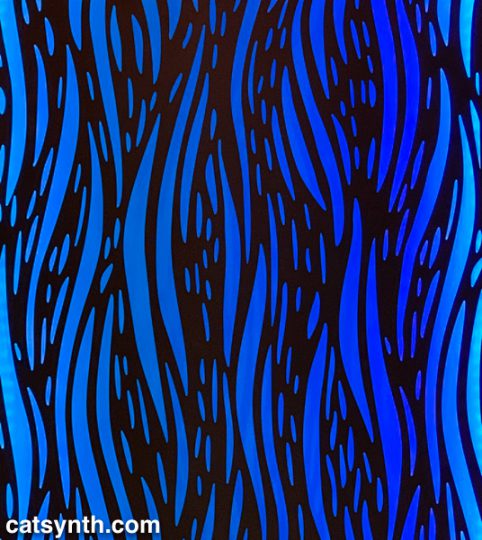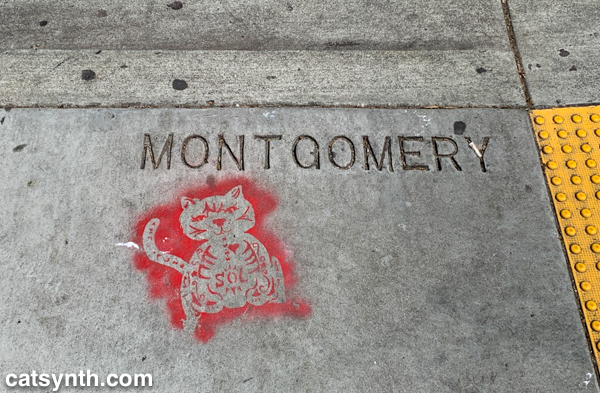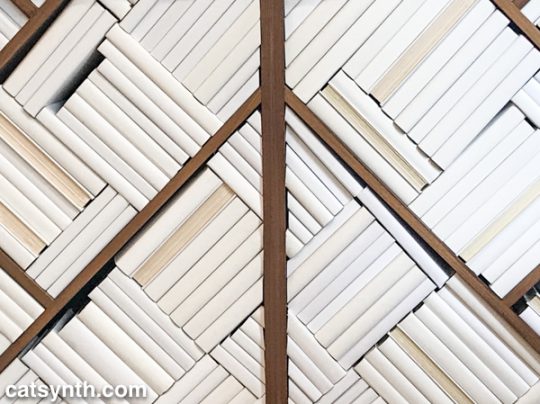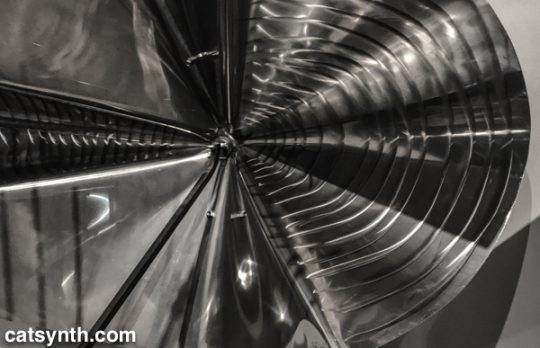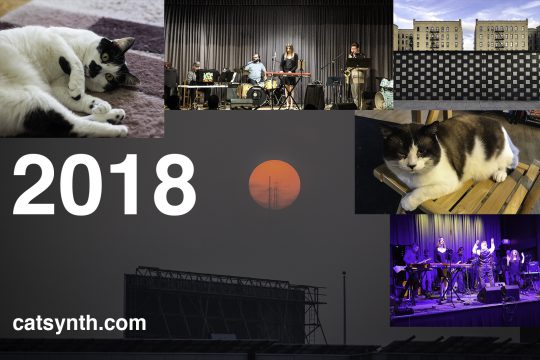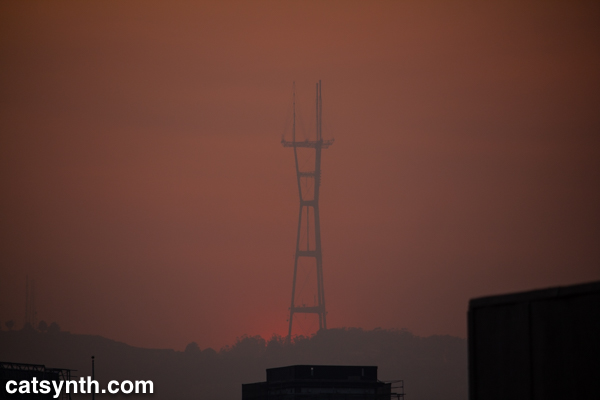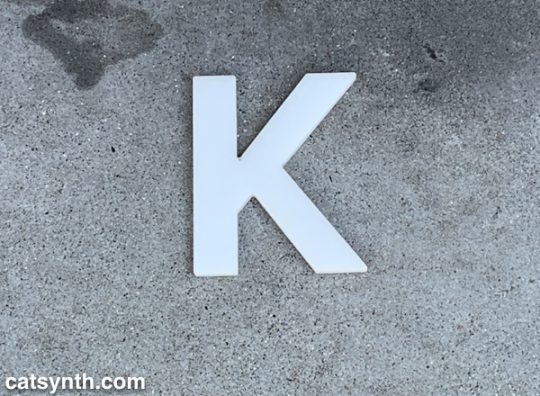
San Francisco
Wordless Wednesday: Blue
Word Performances and The Nunnery
After a couple of months away from live performance, I found myself playing two shows in one weekend, both in the Mission District of San Francisco. They were an exercise in contrasts artistically, but both were delightful in different ways.
Word Performances is a “variety show” of poets, musicians, and dancers produced by Cybele Zufolo Siegel and Todd Siegel. The latest incarnation took place at the Lost Church, a favorite venue of mine for its cozy theater and visual vibe reminiscent of David Lynch.
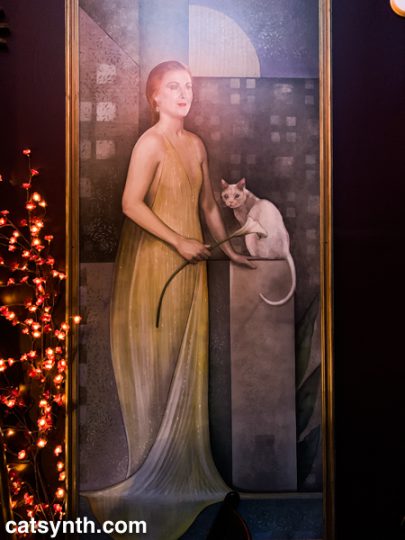
Like any good variety show, it features a staple of regular players that includes both Cybele and Todd, but also Pitta of the Mind as a recurring act. There were of course new participants as well, especially among the poets. You can see a bit of everyone in our video from the evening.
As is clear from the short excerpts, there was a diversity of styles and subject-matter. There were the spartan settings of the readings by Rose Heredia, Jon Sindell, Crystal Jo Reiss, and William Taylor, Jr. Todd and Cybele also gave readings, but with violin accompaniment provided by Hannah Glass. And flamenco Dancer Damian Alvarez stole the show with his tightly choreographed dance to the music of James Brown.
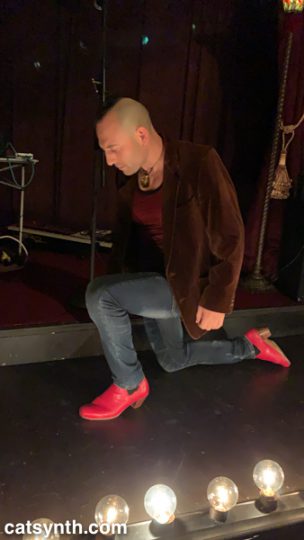
For Pitta of the Mind – myself and poet Maw Shein Win – we performed a brand new set with new poems, and a new color theme of green. The instruments were the same as for our previous performances, combining the Nord Stage, Prophet 12, and modular synthesizers. The consistency in structure and instrumentation helps in our ability to quickly come up with a new set.
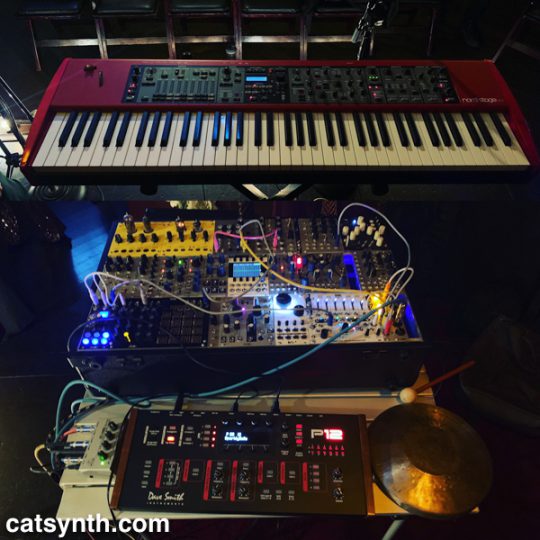
Other than my psychedelic lights not working as expected, it was a solid set overall, and we are always happy to be part of the Word Performances shows.
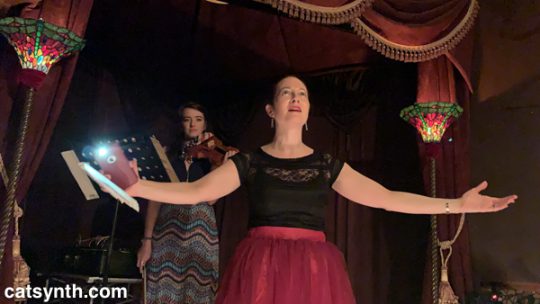
If Word Performances provided a diversity of styles and media, the show later that weekend was very focused on invented instruments, unusual sounds, and the birthday of our friend David Michalak. You can see a bit of everyone in our CatSynth TV video (with David giving the valedictory tag).
This was the first time I performed as a duo with Scott Looney, but I was quite happy with the results. We are both skilled improvisers and were able to blend our sounds and ideas together seamlessly, with my performing on an Arturia MiniBrute 2 and Scott on a custom string instrument with various preparations.
Our set as well as the one that followed us featuring Tom Nunn, David Michalak, and Aurora Josephson had a similar texture: a lot of wisps, scrapes, and staccato elements. It was interesting to see how much musically David could get out of a flat piece of cardboard! The opening set with Tom Nunn on skatchbox and Ron Heglin on voice also had a very pointed and sparse texture.
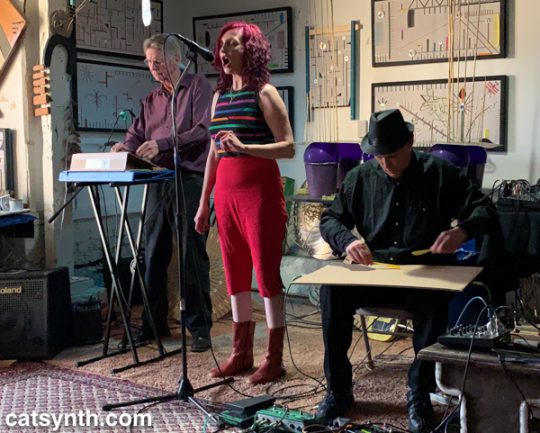
The final set featuring Ghost in the House had a softer, longer, and more liquidy quality. This time David Michalak was performing with a processed harmonica and lap steel guitar, with long tones matched by Polly Moller Springhorn on bass flute and Cindy Webster on musical saw – and this was no ordinary musical saw, it seemed built specifically for music.
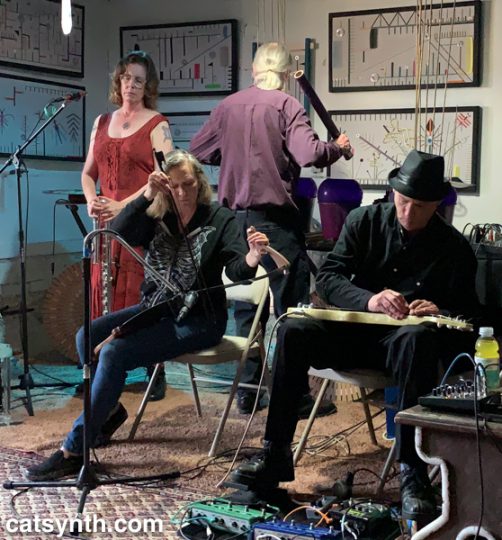
Overall, it was a fun show, and of high quality musically. It’s a shame more people weren’t able to hear it live – it was a private event – but the video captures much of the experience in a compact form.
Wordless Wednesday: Montgomery
Wordless Wednesday: Books
Wordless Wednesday: Après Baschet
Farewell to 2018
The end-of-year colage has become a long-standing tradition here at CatSynth, and one that I particularly enjoy. It was a complex year, and the images reflect that. Our cats Sam Sam and “Big Merp” (who has pretty much become an indoor-outdoor cat at his new home in Oakland), some great shows including outstanding performances with CDP and Vacuum Tree Head, a wonderful and restorative visit back to New York. It was also dark and fiery at times, as when the Camp Fire leveled the town of Paradise and bathed our sky in smoke and ash – beautiful and tragic all at once.
Another New Year tradition at CatSynth is to share some stats from the past year. First, the basics:
- 309 posts
- 169 Cat-and-music posts
- 78 episodes of CatSynth TV
Our top posts for the year, using the somewhat shaky measurements of Google Analytics:
- Wordless Wednesday: Windmill (Golden Gate Park)
- Aretha Franklin: Rock Steady
- Secret Chiefs 3 and Cleric play Zorn’s Masada
- Women’s March 2018 in San Francisco
- CatSynth Pic: White Cat and Modular, Vertical View
It was heartening to see such a diverse set of posts top the list. However, this belies the fact that blog readership is way down, and eclipsed by Facebook and YouTube / CatSynth TV. Most of our referrals to the blog come from these two sources; but most activity stays on Facebook and YouTube. On the plus side, CatSynth TV viewership has grown significantly. Here are the top videos for the year.
- NAMM 2018: Mellotron! [Episode 34]
- Arturia MiniBrute 2 Part 1
- Arturia MiniBrute 2 Sequencer [Episode 61]
- NAMM 2018: Rossum Electro Music Assimil8or [Episode 31]
- Volca FM: Deconstructed Electric Piano [Episode 53]
Clearly, the NAMM reviews and synth demos dominate the channel, though I am proud of the diversity of art, music, and culture topics shared there as well. Overall, we at CatSynth do see the writing on the wall, and the efforts in 2019 will probably accelerate the shift from blog to video in terms of time, energy and investment.
On a more personal and introspective note, 2018 was a year we accomplished a lot. At the same time, it ends feeling like I both did too much and didn’t do enough. There are still so many things going on, even as we tried to consolidate and focus. One of the challenges going into 2019 will be looking at how to stay organized and even more focused, without giving up on all that we do. Also, like birthdays, a new year is a reminder that time is passing, and we are getting a bit older. Taking care of myself will also be a priority.
Thank you all as always for sharing this past year with us, and wish wish everyone a Happy New Year!
Rova Saxophone Quartet and Life’s Blood Trio at VAMP, Oakland
As 2018 draws to a close, we look back a recent show we saw at VAMP (vintage – art and music – for the people) in Oakland. It was the subject of our most recent CatSynth TV.
As one can see at the start of the video, it was pouring rain that night. And it did not let up for the entire evening. But that did not stop an intrepid collection of music lovers from settling into VAMP’s small and quirky space to hear two great ensembles.
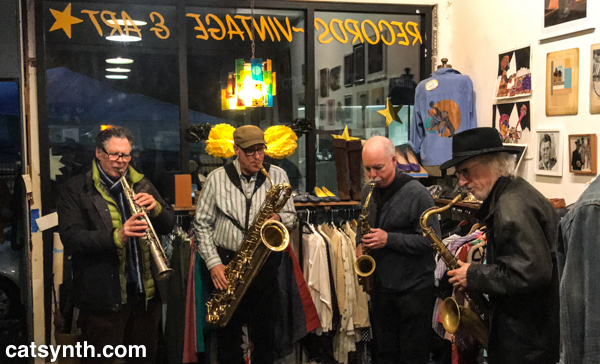
The venerable Rova Saxophone Quartet have been performing together for 40 years, so it’s not surprising that they have coalesced into a sound all their own. Each of the four members, Bruce Ackley, Steve Adams, Larry Ochs, and Jon Raskin, have their own character, but as a group they function as one instrument. This is true even during fast runs, as they did in the latter half of the set, and when various members drop out or “solo” for a section.
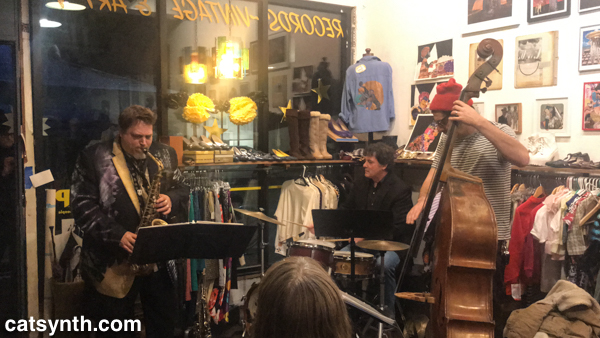
Rounding out the evening was the Life’s Blood Trio, led by Rent Romus (saxophones) and featuring Safa Shokrai on upright bass and Timothy Orr on drums. This is a version of the larger Life’s Blood Ensemble pared down to its essentials. But there is still a rich and full sound in the spartan setting, with the three members filling the full harmonic and textural space. Romus’ performance is always expressive and frenetic, filled with emotion. Shokrai played an amazing extended bass solo. Orr kept things grounded, including during a solo of his own.
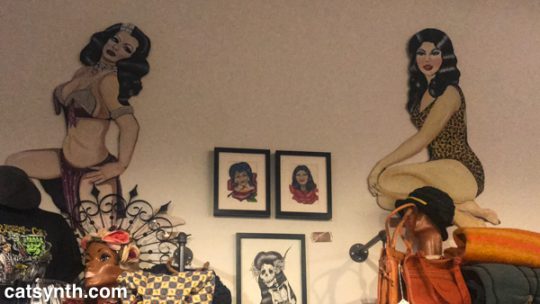
VAMP is a bit of a performance in an of itself, with its odd collection of items for sale and a record collection that requires one to sift through and look for surprises. They’ve been holding on, even as Oakland changes in myriad ways. We look forward to seeing more music there – and perhaps playing there again – in 2019
Wordless Wednesday: San Francisco Under Smoke
Weekend Cat Blogging with Sam Sam: Sheltering from #CaliforniaFires
California is on fire. To our south, the area northwest of Los Angeles that I remember fondly from past visits in on fire, including Malibu and Thousand Oaks. To our north, the devastating Camp Fire has laid waste to much of the town of Paradise, is threatening Chico, and is among the smokiest I have ever experienced. If anything the air quality in San Francisco is even worse than it was during last year’s wine-country fires, which were much closer.
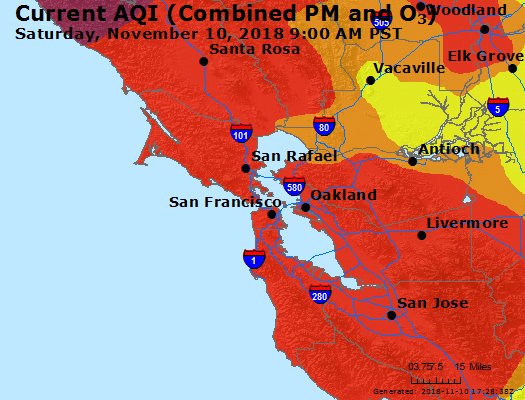
We’re mostly hiding indoors during this time, at least as much as we can. Even just opening the patio door for a minute left my eyes watering and nose as if I was just breathing straight out of a charcoal grill. Yesterday, Sam Sam seemed quite distressed as the particulates seeped into HQ (mostly from the main hallway). Today is slightly better, and she is more like her normal goofy self, including showing off her
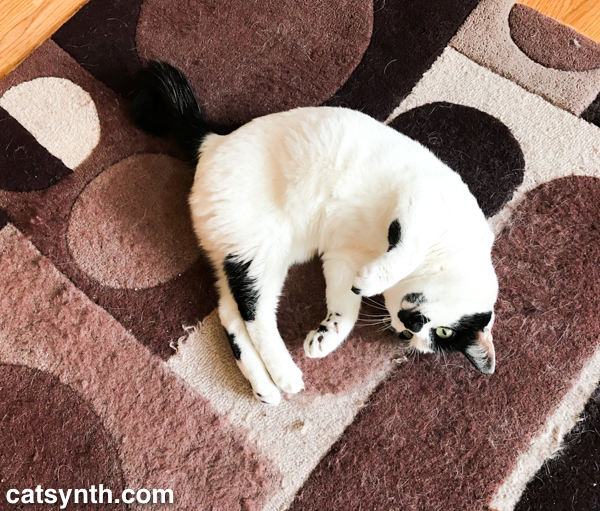
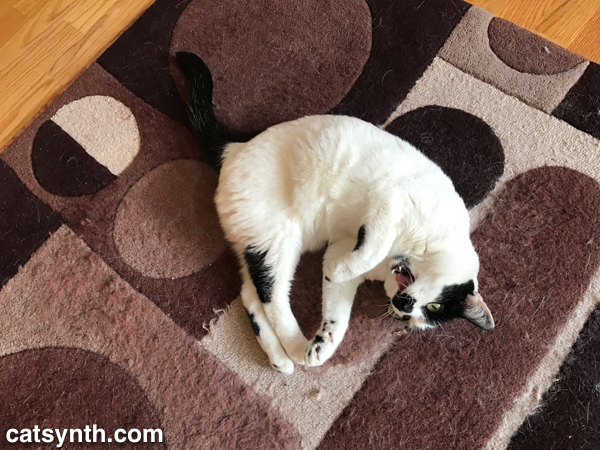
But she still is finding places to hide – if I can smell the smoke, I can only imagine it’s much more intense for her. Yesterday, before I left for work, she jumped up on my chest and snuggled in, wanting me to stay and be close. I had to go, but came home as soon as I could after my in-office responsibilities were done.
We do also worry about our pal Marlon in Oakland, who spends much of his time outside.
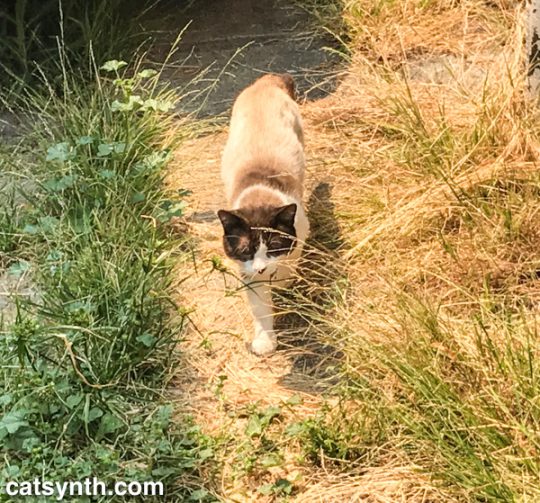
The light from the smoky skies is stunningly beautiful. It’s amazing how such beauty can arise from something as awful as this.
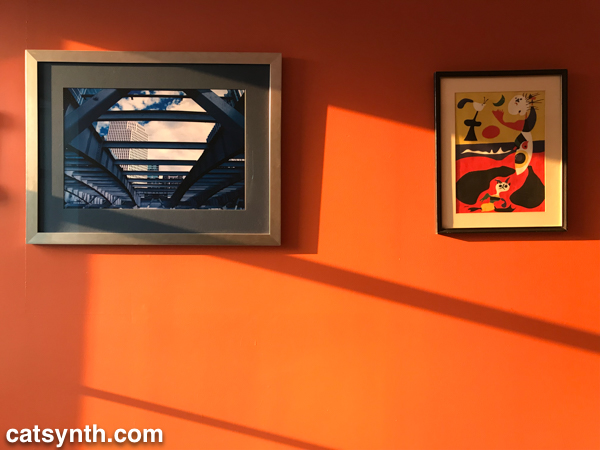
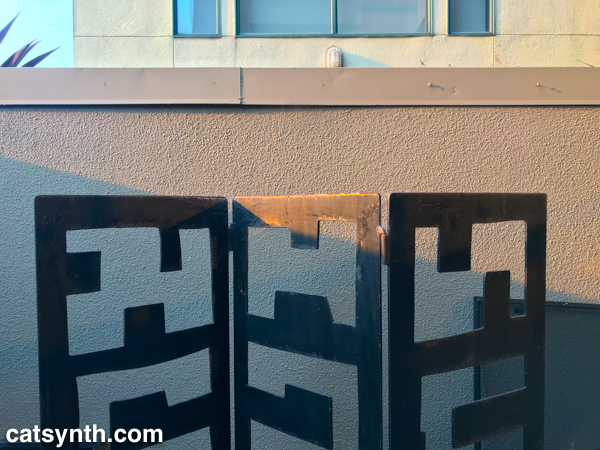
But in all, we need to put our challenges in perspective. I can’t imagine the horror and pain people in the fire zones are going through, losing their homes, fearing for their loved ones, and of course their companion animals. The messages I see from people searching for their missing cats, or the heartbreak of not being able to rush home to rescue them, is painful and our hearts go out to them. Other animals, too, of course, as we hear about horses, dogs, and birds.
Both north and south zones have evacuation shelters for those who have small or large animals. In the north, Butte County has set up a line for those who either find and are searching for lost pets in coordination with North Valley Animal Disaster Group.
NVADG is active both in trying to locate and rescue lost pets, as well as running multiple shelters for those with animals. From their website:
NVADG is providing emergency animal sheltering and where and when allowed will evacuate and/or care for animals in evacuation areas.
Animal shelters will be established at:
Small Animal Shelter: 2279 Del Oro Avenue, Oroville. Off Nelson near the County Center and Highway 70.Small Animal Shelter 150 Airpark Dr, Chico at the Chico Airport
Large Animals should be taken to the Rolling Hills Casino Equestrian Center off Highway 5 in CorningIf you want to donate to NVADG, please consider a cash donation. It gives us the flexibility we need and we will definitely need it! Donate on our website or send a check to NVADG, PO Box 441, Chico, CA 95927.
We certainly hope all the fires around our home state are brought under control soon, and the air returns to normal as well. Then the hard work of rebuilding begins…

